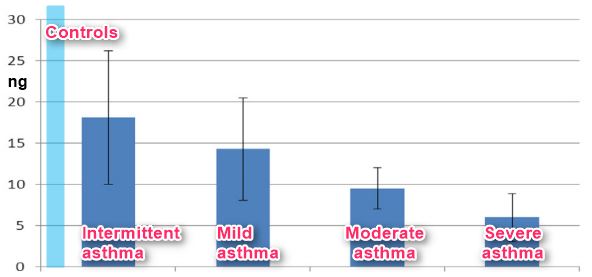Adult-onset asthma 2X more likely if low vitamin D and not hyperallergenic
Association between Serum 25-Hydroxy Vitamin D Levels and the Prevalence of Adult-Onset Asthma
Int. J. Environ. Res. Public Health 2018, 15(6), 1103; https://doi.org/10.3390/ijerph15061103
 Atopy Model Adjustments
* Model 1 ¶ Adjusted for sex and season;
* Model 2 # additionally adjusted for smoking status at age 42, TV and PC time, physical activity at age 42, outdoor activity at age 46, oily fish consumption, vitamin D supplementation at age 46, region of residence at age 46, occupational social class at birth (father’s occupation) and at age 46;
* Model 3 ¥ additionally adjusted BMI, BMI squared, waist circumference, waist circumference squared.
---
1. See also VitaminDWiki
* Overview Asthma and Vitamin D
* Asthma reduced 60 percent with vitamin D supplementation – meta-analysis 2014, 2015
* Proof that Vitamin D Works 86 health problems prevented/treated as of May 2018
* Asthma has been proven to be treated by Vitamin D in at least 4 random controlled trials
* The worse the bronchial asthma, the lower the vitamin D – Jan 2017
Atopy Model Adjustments
* Model 1 ¶ Adjusted for sex and season;
* Model 2 # additionally adjusted for smoking status at age 42, TV and PC time, physical activity at age 42, outdoor activity at age 46, oily fish consumption, vitamin D supplementation at age 46, region of residence at age 46, occupational social class at birth (father’s occupation) and at age 46;
* Model 3 ¥ additionally adjusted BMI, BMI squared, waist circumference, waist circumference squared.
---
1. See also VitaminDWiki
* Overview Asthma and Vitamin D
* Asthma reduced 60 percent with vitamin D supplementation – meta-analysis 2014, 2015
* Proof that Vitamin D Works 86 health problems prevented/treated as of May 2018
* Asthma has been proven to be treated by Vitamin D in at least 4 random controlled trials
* The worse the bronchial asthma, the lower the vitamin D – Jan 2017

📄 Download the PDF from VitaminDWiki
Mark P. C. Cherrie 1,2, Christophe Sarran 3 and Nicholas J. Osborne 2,4,*
1 Centre for Research on Environment, Society and Health, Institute of Geography, Drummond Street, Edinburgh EH8 9XP, UK
2 European Centre for Environment and Human Health, University of Exeter Medical School, Truro TR1 3HD, UK
3 Met Office, FitzRoy Road, Exeter, Devon EX1 3PB, UK
4 School of Public Health and Community Medicine, University of New South Wales, Sydney 2052, Australia
(This article belongs to the Special Issue The Epidemiology of Allergy)
The major circulating metabolite of vitamin D (25(OH)D) has been implicated in the pathogenesis for atopic dermatitis, asthma and other allergic diseases due to downstream immunomodulatory effects. However, a consistent association between 25(OH)D and asthma during adulthood has yet to be found in observational studies. We aimed to test the association between 25(OH)D and asthma during adulthood and hypothesised that this association would be stronger in non-atopic participants. Using information collected on the participants of the 1958 birth cohort, we developed a novel measure of atopic status using total and specific IgE values and reported history of eczema and allergic rhinitis. We designed a nested case-control analysis, stratified by atopic status, and using logistic regression models investigated the association between 25(OH)D measured at age 46 years with the prevalence of asthma and wheezy bronchitis at age 50 years, excluding participants who reported ever having asthma or wheezy bronchitis before the age of 42. In the fully adjusted models, a 10 nmol/L increase in serum 25(OH)D prevalence had a significant association with asthma (aOR 0.94; 95% CI 0.88–1.00). There was some evidence of an atopic dependent trend in the association between 25(OH)D levels and asthma. Further analytical work on the operationalisation of atopy status would prove useful to uncover whether there is a role for 25(OH)D and other risk factors for asthma.
This page was renamed Jan 2019.
There have actually been visitors to this page since it was originally made
